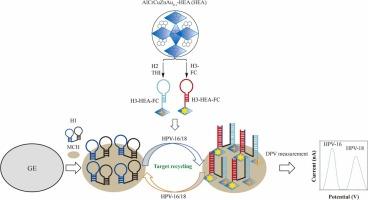高熵合金纳米颗粒催化双信号扩增和靶DNA循环用于人血清HPV-16/18的超灵敏检测
IF 3.7
1区 化学
Q1 CHEMISTRY, ANALYTICAL
引用次数: 0
摘要
快速鉴定HPV-16/18基因型对预防宫颈癌至关重要,但由于诊断敏感性和特异性不足,临床仍无法实现。本文介绍了一种电化学DNA生物传感器,通过创新的双信号放大级联实现基因型检测。首先,利用叶酸和组氨酸功能化的硼和氮掺杂石墨烯量子点,通过配位驱动的方法设计了一种异常活跃的AlCrMnZnAu0.1高熵合金。协同原子轨道杂化和量身定制的支持赋予了前所未有的稳定性、优化的电子结构和卓越的催化活性——比基准金纳米粒子高出6.8倍。其次,锚定在金电极上的三段聚腺嘌呤探针(H1)选择性捕获HPV-16或HPV-18靶点。结合启动二级结构的展开:HPV-16的H2(标记为AlCrMnZnAu0.1/硫氨酸)和HPV-18的H3(标记为AlCrMnZnAu0.1/二茂铁)。至关重要的是,目标DNA通过支点介导的链位移再生,从而实现几何信号放大。同时,AlCrMnZnAu0.1通过催化促进硫氨酸和二茂铁氧化还原反应来增强电化学响应。这种精心策划的双重扩增策略为HPV-16/18提供了无与伦比的特异性和敏感性。该平台对两个目标都表现出非常广泛的线性反应(10⁻¹⁸至10⁻¹³ M),并达到了2.9 × 10⁻¹ ⁹ M的超低检测限,这代表了现有最先进的诊断传感器在医疗点部署方面的革命性进步。本文章由计算机程序翻译,如有差异,请以英文原文为准。

Dual-signal amplification via high-entropy alloy nanoparticle catalysis and target DNA recycling for ultrasensitive HPV-16/18 detection in human serum
Rapid identification of HPV-16/18 genotypes is critical for cervical cancer prevention, yet remains clinically inaccessible due to inadequate diagnostic sensitivity and specificity. The paper presents an electrochemical DNA biosensor achieving detection of genotypes through an innovative dual-signal amplification cascade. First, an exceptionally active AlCrMnZnAu0.1 high-entropy alloy was engineered via coordination-driven approach using folic acid and histidine-functionalized boron and nitrogen-doped graphene quantum dot. Synergistic atomic orbital hybridization and tailored support endow unprecedented stability, optimized electron structure and remarkable catalytic activity—outperforming benchmark gold nanoparticle by 6.8-fold. Second, triblock poly-adenine probe (H1) anchored to gold electrode selectively captures HPV-16 or HPV-18 targets. Binding initiates the unfolding of secondary structures: H2 (tagged with AlCrMnZnAu0.1/thionine) for HPV-16, and H3 (tagged with AlCrMnZnAu0.1/ferrocene) for HPV-18. Crucially, target DNA is regenerated through toehold-mediated strand displacement, enabling geometric signal amplification. Concurrently, AlCrMnZnAu0.1 intensifies electrochemical responses by catalytically boosting thionine and ferrocene redox reactions. This orchestrated dual-amplification strategy delivers unmatched specificity and sensitivity for HPV-16/18. The platform exhibits an exceptionally broad linear response (10⁻¹⁸ to 10⁻¹³ M) for both targets and achieves ultralow detection limit of 2.9 × 10⁻¹ ⁹ M, representing a transformative advancement over existing state-of-the-art diagnostic sensors for point-of-care deployment.
求助全文
通过发布文献求助,成功后即可免费获取论文全文。
去求助
来源期刊

Sensors and Actuators B: Chemical
工程技术-电化学
CiteScore
14.60
自引率
11.90%
发文量
1776
审稿时长
3.2 months
期刊介绍:
Sensors & Actuators, B: Chemical is an international journal focused on the research and development of chemical transducers. It covers chemical sensors and biosensors, chemical actuators, and analytical microsystems. The journal is interdisciplinary, aiming to publish original works showcasing substantial advancements beyond the current state of the art in these fields, with practical applicability to solving meaningful analytical problems. Review articles are accepted by invitation from an Editor of the journal.
 求助内容:
求助内容: 应助结果提醒方式:
应助结果提醒方式:


